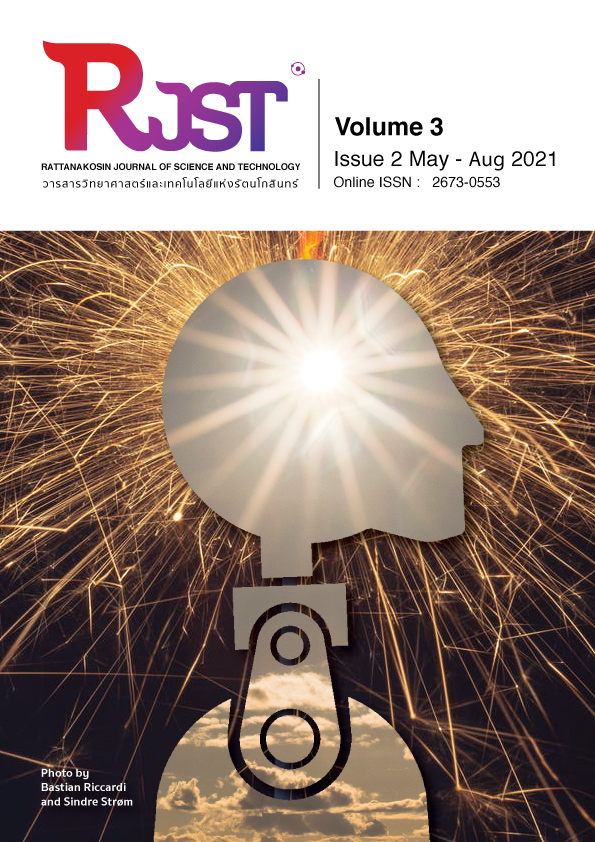Lateritic Soil Stabilized with Bottom Ash Geopolymers for road work
Main Article Content
Abstract
The objective of this research is to study the unconfined compressive strength of lateritic soil stabilized with bottom ash geopolymer. Lateritic soil (LS) was mixed with ground bottom ash (BA) passing no. 325 sieve at LS:BA ratios of 70:30, 50:50, and 30:70. A liquid alkali activator was used instead of water, which was a mixture of sodium silicate (Na2SiO3) solution and sodium hydroxide (NaOH) solution at Na2SiO3:NaOH ratios of 0:100, 10:90, 30:70, and 50:50. The quantities of the liquid alkali activator used in specimen preparations by compacting were optimum moisture content (OMC), OMC minus 2% (dry side), and OMC plus 2% (wet side). After sample preparations, they were cured in oven at 65 °C for 7 days. Then, the samples were taken to soak for 2 hours prior to testing. The results reveal the best proportion of LS:BA was 30:70 and the best Na2SiO3:NaOH ratio was 50:50. The recommended proportions of LS:BA and Na2SiO3:NaOH for road work were, 50:50 and 10:90, respectively.
Article Details
The content within the published articles, including images and tables, is copyrighted by Rajamangala University of Technology Rattanakosin. Any use of the article's content, text, ideas, images, or tables for commercial purposes in various formats requires permission from the journal's editorial board.
Rajamangala University of Technology Rattanakosin permits the use and dissemination of article files under the condition that proper attribution to the journal is provided and the content is not used for commercial purposes.
The opinions and views expressed in the articles are solely those of the respective authors and are not associated with Rajamangala University of Technology Rattanakosin or other faculty members in the university. The authors bear full responsibility for the content of their articles, including any errors, and are responsible for the content and editorial review. The editorial board is not responsible for the content or views expressed in the articles.
References
[2] Muduli, S. D., Sadangi, J. K., Nayak, B. D. and Mishra, B. K. (2013). Effect of NaOH concentration in manufacture of geopolymer fly ash building brick. Greener Journal of Physical Sciences. 3(6). 204-221.
[3] Deraman, L.M., Al Bakri Abdullah, M.M., Yun Ming, L., Hussin, K., and Yahya, Z. (2015). A Review on Processing and Properties of Bottom Ash Based Geopolymer Materials. Key Engineering Materials. 660, 3–8.
[4] Suksiripattanapong, C., Tuntawoot, N., Thumrongvut, J., Wonglakorn, N., Chongutsah, S., and Tabyang, W. (2019). Compressive Strength of Marginal Lateritic Soil Stabilized with Bottom Ash Geopolymer as a Pavement Material. International Journal of Engineering and Technology. 11(3). 177-180.
[5] สุภาพร แจ่มเจริญ. (2533). ดินลูกรัง. วิศวกรรมสาร มก. 9. 25-32.
[6] Ghafoori, N. and Bucholc, J. (1997). Properties of High-Calcium Dry Bottom Ash Concrete. ACI Materials Journal, 94(2). 90-101.
[7] Onprom, P., Chaimoon, K., and Cheerarot, R. (2015). Influence of Bottom Ash Replacements as Fine Aggregate on the Property of Cellular Concrete with Various Foam Contents. Advances in Materials Science and Engineering. 2015.381704.
[8] Cheriaf, M., Rocha, J. C. and Pera, J. (1999). Pozzolanic Properties of Pulverized Coal Combustion Bottom Ash, Cement and Concrete Research. 28(9). 1387-1391.
[9] Jaturapitakkul, C. and Cheerarot, R. (2003). Development of Bottom Ash as Pozzolanic Material. Journal of Materials in Civil Engineering. 15(1). 48-53.
[10] เรืองรุชติ์ ชีระโรจน์ และชัย จาตุรพิทักษ์กุล. (2546). การใช้เถ้าก้นเตาบดละเอียดเป็นวัสดุปอซโซลานในงานคอนกรีต. วิศวกรรมสาร ฉบับวิจัยและพัฒนา. 14(2). 1-8.
[11] อุมาพร ปฏิพันธ์ภูมิสกุล และประทีป ดวงเดือน. (2553). การปรับปรุงคุณภาพดินลูกรังโดยใช้เถ้าก้นเตา เศษปูนขาวและโซเดียมไฮดรอกไซด์. การประชุมวิชาการวิศวกรรมโยธาแห่งชาติ ครั้งที่ 15.


